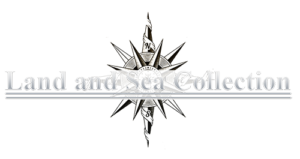Henry Hughes & Son – London
Double Frame Brass Sextant/Quintant
Dated 1895
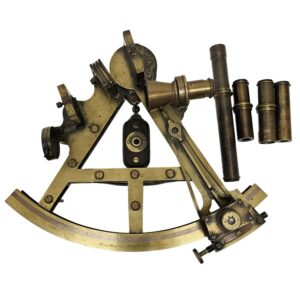
. This high-quality instrument has its original factory finish.
It belongs in a collection of fine nautical antiques or as an important gift or presentation piece.
Presented is an important instrument which we believe was a private label for Henry Hughes &, Son, possibly made by Troughton & Simms. It was specially ordered for T. Quail, 1895.
Troughton & Simms and Henry Hughes & Son were the best of the English Class A instrument makers.
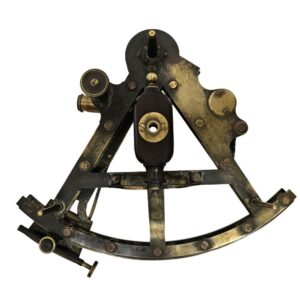
Back View of Sextant
 |
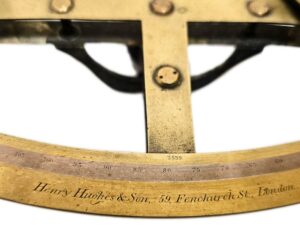 |
This is a rare double frame quintant or sextant that we believe was made by Troughton & Simms – London, the patent holder
of this design since 1788, because it is the same as those made by them except for the platinum arc.
As pictured above, the back of the sextant shows the two straight bar pillar frames
that are held together with twenty-one pillars and their screw fittings. There is a turned Rosewood or ebony handle with threaded
brass insert for mounting the instrument when taking bearing angles. The tangent screw and clamping screw are positioned on
the back of the index arm. The device has four square index shades and three round horizon shades. The telescopes are attached
to a perpendicular rising piece which is adjusted in and out by a milled knob. There is also a very unusual focusing magnifier traveling
over the vernier. This is a unique design we have not seen before. The brass limb is inlaid with a platinum scale from -5° to 155° divided
each 5 degrees. The platinum vernier measures from right to left from 0 to 10° in arc seconds.
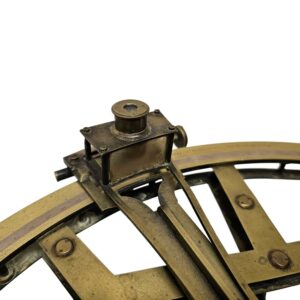
Unusual focusing magnifier
It has survived all these years in its original hardwood case with campaign hardware and carries its factory-painted
midnight black coating primarily on the back side of the instrument. The serial number 3539 is on its center limb. Beneath it, on its lower limb, it is marked, “Henry Hughes & Son, 59 Fenchurch St., London” which is the name of the instrument maker and dealer for whom we believe it was a special order. The instrument’s Rosewood or ebony handle has a threaded brass insert which was used to mount the instrument on a horizontal plane to take bearing angles of terrestrial objects. It is in a square case whose exterior has a pleasing finish with a brass plate engraved for the owner, T. Quail.
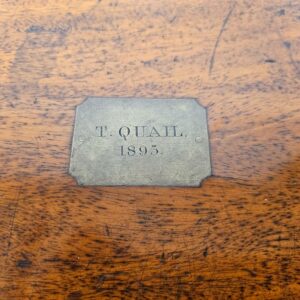
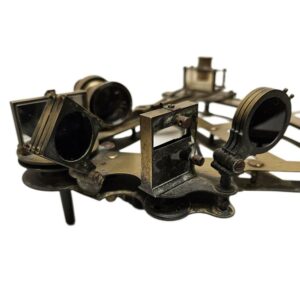 |
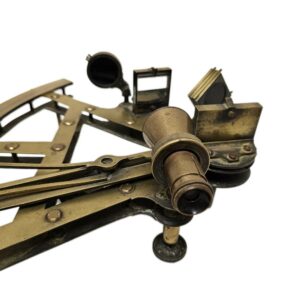 |
The two original brass sighting
tubes and two telescopes with front and rear optics were left “as found”. The arc is brass with
a platinum insert for the gradations and is marked “Platima & Gold”, 3539 above the 80/75 degree mark.
Edward Troughton was the inventor of this design and patented it in 1788, with other makers copying his design, so the Hughes firm may be the actual maker. The instrument’s arc is graduated into 155 degrees which classifies it as a Quintant. Brass
became the accepted material of choice for sighting instruments in the later 19th Century because of its strength and durability.
The double-frame design was expensive to make and never gained the popularity of the more common single, cast-frame instruments.
Consequently, there are not that many that come to market. Double-frame instruments look spectacular so they make an ideal gift and a wonderful reminder of navigation in the the 19th Century. Back of Double Frame sextant marked Henry Hughes & Son
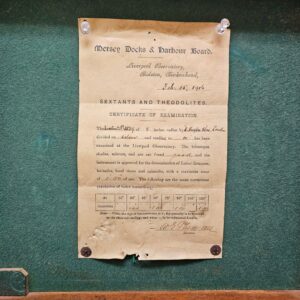
A Certificate of Examination by The Mercy Docks & Harbour Board is present dated Feb. 15, 1916. there is also a dealer’s label in the box of Kelvin, White & Hutton, nautical instrument dealers in London.
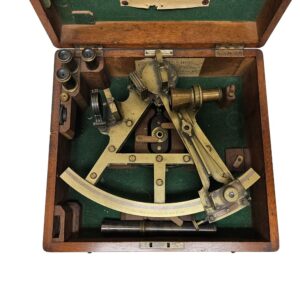
Length of index arm 10 1/4″
Radius of arc 12 1/2″
Width of frame at arc 11 ″
Index mirror 48 x 35 mm
Horizon mirror 28 x 26 mm
4 index shades 3 horizon shades
Sextant Weight 3 Lbs 4 1/4 oz
CASE: 13″ x 12″ x 5 1/2″
Total weight 9 lbs 7oz.
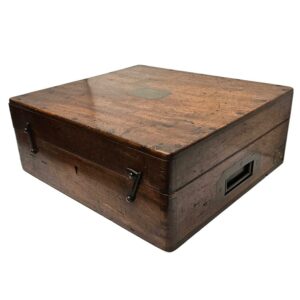 |
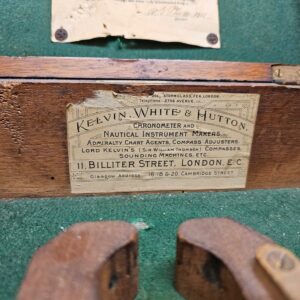 |
BRIEF HISTORY OF THE HUGHES FAMILY
The Hughes family were originally clockmakers in the East End of London who progressed
into supplying sextants and chronometers to ships coming into the River Thames. In 1712 Thomas
Hughes became a member of the Worshipful Company of Clockmakers at the age of 26 and was elected as Master of the Worshipful
Company of Clockmakers in 1742. His son, Thomas Hughes (junior), had his business at 25 New Bond Street, London, and was
elected as Master of the Worshipful Company of Clockmakers in 1762. In 1781 William Hughes,
believed to be the son of Thomas Hughes Junior, was elected freeman of the Worshipful Company of Clockmakers, and sold a cabin
clock to Captain Cook. Joseph Hughes, believed to be the son of William born in 1781, lived and worked at 16 Queen Street,
Ratcliffe. He was to become a well-known maker of quadrants and compasses. His son Henry Hughes was born in 1816. Henry Hughes & Son was founded in 1838 at 120, later 59, Fenchurch St. in
London, as an optician and maker of chronographic and scientific instruments. Henry died in 1879
and his son Alexander succeeded him as chairman. The firm was incorporated as Henry Hughes & Sons Ltd in 1903 and
in 1923, the company produced its first recording echo sounder. In 1935, a controlling interest in the company was acquired
by S. Smith & Son Ltd resulting in the development of marine and aircraft instruments. Following the London office’s
destruction in the Blitz of 1941, a collaboration was entered into with Kelvin, Bottomley & Baird Ltd, resulting in the
establishment of Marine Instruments Ltd. Following the formal amalgamation of Kelvin, Bottomley & Baird Ltd and Henry
Hughes & Sons Ltd in 1947 to form Kelvin & Hughes Ltd, Marine Instruments Ltd acted as regional agents in the UK for
Kelvin & Hughes Ltd who were essentially now a part of Smith’s Industries Ltd founded in 1944 as the successors of
S. Smith & Son Ltd. The well-known “HUSUN”
trademark was in use starting in the 1920s.
